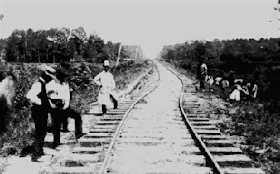 The purchase of my first train set is the typical boy's tale revolving around the saving of tips from paper delivery. After accumulating the necessary funds, I purchased it from a discount store, no longer in existence. It was an HO scale train set with two blue-gray diesel locomotives. As time passed-by, I expanded the tracks, added more cars and more accessories. Spent countless hours at my cousin's house setting up the trains and running them. Classic boyhood fun and all part of the love affair with trains.
The purchase of my first train set is the typical boy's tale revolving around the saving of tips from paper delivery. After accumulating the necessary funds, I purchased it from a discount store, no longer in existence. It was an HO scale train set with two blue-gray diesel locomotives. As time passed-by, I expanded the tracks, added more cars and more accessories. Spent countless hours at my cousin's house setting up the trains and running them. Classic boyhood fun and all part of the love affair with trains.The real-life, full-scale versions have fascinated people since the steam locomotive's first appearance in the late 1700's and continue to fascinate the masses today, especially the massive iron horses of the 1800's. There is something soothing about the sound of the clickety-clack of the steel wheels on the steel tracks that brings to mind simpler times and massages our curiosity on how our predecessors experienced life. Summerville's place in that history is well documented as evidenced by Monday's festivities.
 Our "Best Friend" rolled into town and Summerville's residents came out in large numbers to greet and celebrate the historic arrival. It was the final stop of a long journey that began six years ago. After leaving Summerville, "Best Friend" will complete the journey in downtown Charleston where permanent residence have been arranged, a glass enclosure on John Street. It is the famous steam locomotive owned by the City of Charleston.
Our "Best Friend" rolled into town and Summerville's residents came out in large numbers to greet and celebrate the historic arrival. It was the final stop of a long journey that began six years ago. After leaving Summerville, "Best Friend" will complete the journey in downtown Charleston where permanent residence have been arranged, a glass enclosure on John Street. It is the famous steam locomotive owned by the City of Charleston.This "Best Friend" was built in the late 1920's for the centennial of the South Carolina Canal and Railroad Company. It is a replica of the original "Best Friend", which made its first run on December 25, 1830 for the Southern Railway System. Summerville was the first stop out of Charleston on the railway.
 The replica was displayed in front of the Summerville-Dorchester Museum on E Doty Ave next to the tracks not far from where the train stations once stood. Patrick Barber, owner of Superior Transportation and the flatbeds used to transport the brightly painted replica, beamed with pride.
The replica was displayed in front of the Summerville-Dorchester Museum on E Doty Ave next to the tracks not far from where the train stations once stood. Patrick Barber, owner of Superior Transportation and the flatbeds used to transport the brightly painted replica, beamed with pride.We chatted and I asked questions. I knew the original "Best Friend" was only in service a short time due to an accident, but Patrick detailed the unfortunate event. "The locomotive was destroyed by a boiler explosion later attributed to the ignorance of the engineer who seeking to take a nap under a tree disabled the safety valve with his bandanna to prevent it from making its usual loud hissing noise," Patrick explained.
 Chris Ohm, director of the Summerville Dorchester Museum, orchestrated the event and fielded questions from the onlookers. Chris and I both agreed building a replica of Summerville's first train station would be a huge tourist draw for Summerville. "The idea of building the train station has been proposed. Maybe, sometime in the future it will be a realistic possibility." The first train station in the 1800's was a classic Victorian Style station decorated with an elaborate gingerbread trim.
Chris Ohm, director of the Summerville Dorchester Museum, orchestrated the event and fielded questions from the onlookers. Chris and I both agreed building a replica of Summerville's first train station would be a huge tourist draw for Summerville. "The idea of building the train station has been proposed. Maybe, sometime in the future it will be a realistic possibility." The first train station in the 1800's was a classic Victorian Style station decorated with an elaborate gingerbread trim.E Doty Ave was lined with vendors - peanuts, popcorn and a stand with lemonade, cider and of course, sweet tea. Steel drum music filled the air. Ken Burger, author of a trilogy of South Carolina stories and "Baptized in Sweet Tea", sported a face painting of the historic locomotive in celebration of the event.
The gathered crowd, boiling over with anticipation, eagerly awaited the storied arrival and when it finally pulled in, expectations were more than satisfied. It was monumental. Cameras and cell phones clicked in concert. Train enthusiasts basked in the nostalgia. The older residents recalled it. The adults amazed at it. The kids loved it. I wondered how the engineer dealt with the weather elements and what it would have been like to ride in the open-air coaches.
During the festivities, a freight train on its way to Charleston cruised past blasting its powerful horns repeatedly in respectful recognition of its forerunner as the engineer waved to the crowd. A reminder the Southern Railway System extending out of Charleston with Summerville its one-time first stop, the first railway to carry U.S. mail, is still actively hauling freight today. Although not passengers, there is always the dream. It was Summerville's day to blow its whistle and bath in the glory.



























